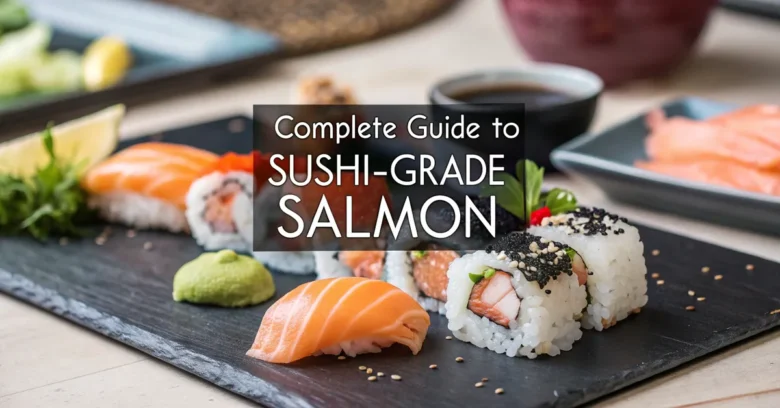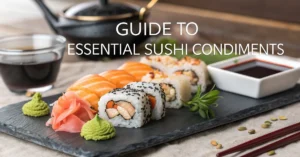Craving a perfect sushi night at home? The secret isn’t just in the rolling—it’s in the salmon. But how do you know you’re choosing salmon that’s safe and delicious enough to eat raw? Navigating the world of “sushi-grade” fish can feel like decoding a secret language.
This guide will arm you with the knowledge you need to confidently select the right salmon. We will explore everything from understanding what “sushi-grade” truly means to identifying key indicators of quality and freshness. Whether you’re a seasoned sushi chef or a curious beginner, get ready to unlock the secrets to choosing salmon that will impress your taste buds and keep you healthy.
Complete Guide to Sushi-Grade Salmon
Unpacking “Sushi-Grade”: What Does It Really Mean?
The term “sushi-grade” gets tossed around a lot, but it’s not an official standard regulated by the FDA or any governing body in the U.S. What it should indicate is that the fish supplier has taken precautions to ensure the fish is safe to eat raw.
Think of “sushi-grade” as a promise. It’s a vendor telling you they’ve followed best practices for handling, processing, and freezing the fish. These practices reduce the risk of parasites and bacterial contamination.
However, it is up to you to confirm that these best practices have been maintained by asking key questions from your fishmonger.
Why Freezing Matters: The Parasite Factor
One of the biggest risks of eating raw fish is the potential for parasite exposure. Many types of wild fish, including salmon, can harbor parasites. These parasites are only harmful if consumed live.
Freezing is a common and effective way to eliminate this risk. According to FDA guidelines, to be safely consumed raw, fish must be frozen according to one of these protocols:
- Freezing and Storage: Fish must be frozen at -4°F (-20°C) or below for 7 days (total time).
- Freezing: Fish must be frozen at -31°F (-35°C) or below until solid and stored at -31°F (-35°C) or below for 15 hours.
- Freezing: Fish must be frozen at -31°F (-35°C) or below until solid and stored at -4°F (-20°C) or below for 24 hours.
These freezing processes effectively kill any parasites that may be present in the fish. This makes it safe for raw consumption.
Wild vs. Farmed Salmon: Which is Safer?
The origin of your salmon plays a big part in safety. Here’s what you need to know:
- Wild Salmon: Wild salmon, particularly Pacific varieties, are more likely to harbor parasites than farmed salmon. This is due to their natural diet and environment. If you opt for wild salmon, make sure it has been properly frozen. Ask your fishmonger!
- Farmed Salmon: Many salmon farms now adhere to strict regulations. These regulations often include parasite control measures. Farmed salmon from reputable sources may have a lower risk of parasites. However, freezing is still often recommended as an extra safety precaution.
Always ask about the salmon’s origin. Find out if it has been frozen. Don’t be shy about asking questions about their safety protocols. Reputable fishmongers are happy to provide you with all the information you need.
Key Indicators of Freshness and Quality: What to Look For
Beyond “sushi-grade,” you need to assess the salmon yourself. Use these factors to guide you:
- Smell: Fresh salmon should have a mild, sea-like scent. Avoid anything that smells overly fishy, sour, or ammonia-like. These smells are clear signs of spoilage.
-
Appearance:
- Color: The flesh should have a vibrant color. This could range from a deep red to a lighter pink, depending on the type of salmon. Avoid salmon that looks dull, pale, or has any brownish discoloration.
- Moisture: The salmon should look moist and glistening, not dry or slimy.
- Fat Lines: Look for clear, well-defined fat lines (the white streaks) running through the flesh. These indicate good fat content. They also add to the flavor and texture.
- Texture: The flesh should be firm and spring back when you gently press it. If it feels soft or mushy, it’s past its prime.
- Eyes (If Buying Whole Fish): The eyes should be clear, bright, and slightly bulging. Cloudy or sunken eyes indicate the fish isn’t fresh.
- Gills (If Buying Whole Fish): The gills should be bright red or pink and free from slime. Brown or gray gills are a sign of age.
Shopping Smart: Where to Buy Sushi-Grade Salmon
Where you buy your salmon makes a big difference. Here are your best bets:
- Reputable Fish Markets: These markets specialize in seafood. They have knowledgeable staff who can answer your questions about the salmon’s origin, handling, and freshness.
- High-End Grocery Stores: Some upscale grocery chains have seafood counters with well-trained staff and high standards for quality.
- Japanese Grocery Stores: These stores often carry salmon specifically intended for sushi and sashimi. They are more likely to have the specific types and cuts you need.
- Online Retailers (Proceed with Caution): Buying seafood online can be convenient. However, it is difficult to assess quality before you buy. Only buy from reputable online retailers with a strong track record of delivering fresh, high-quality seafood. Check customer reviews carefully. Ensure they have proper shipping and handling procedures.
Questions to Ask Your Fishmonger
Don’t be afraid to quiz your fishmonger. These questions can help you make an informed decision:
- “Is this salmon sushi-grade?”
- “Where did this salmon come from?” (Wild-caught or farmed?)
- “Has this salmon been frozen according to FDA guidelines?”
- “When was this salmon received?”
- “How has this salmon been stored?”
A knowledgeable and trustworthy fishmonger will be happy to answer these questions. They may even volunteer extra information about the salmon’s quality and handling. If they seem evasive or unsure, it’s best to shop elsewhere.
Understanding Different Types and Cuts of Salmon
Different types of salmon have unique flavor profiles and textures. Here are some popular choices for sushi:
- Atlantic Salmon: Typically farmed, with a rich, buttery flavor and high fat content. This makes it a popular choice for sushi.
- King (Chinook) Salmon: Considered the “king” of salmon, with a rich, melt-in-your-mouth texture and high fat content. It is often wild-caught.
- Sockeye Salmon: Known for its deep red color and strong, distinct flavor. It has a leaner texture than Atlantic or King salmon.
- Coho Salmon: A good mid-range option with a milder flavor and a slightly firmer texture.
Popular Cuts for Sushi:
- Saku: A rectangular block of salmon that is ideal for slicing into nigiri or sashimi. It is usually skinless and boneless.
- Fillet: A side of salmon, with or without the skin. You can slice your own portions from the fillet.
- Belly (Toro): The fattiest part of the salmon, located on the underside. It is prized for its rich flavor and melt-in-your-mouth texture.
Safe Handling Practices at Home
Once you’ve selected your salmon, proper handling at home is crucial to prevent bacterial growth. Follow these steps:
- Keep it Cold: Store the salmon in the coldest part of your refrigerator. This should be below 40°F (4°C). Use a thermometer to check the temperature.
- Use it Quickly: Ideally, use sushi-grade salmon the same day you buy it. If you must store it, use it within 1-2 days maximum.
- Prevent Cross-Contamination: Use separate cutting boards and utensils for raw fish and other foods. Wash everything thoroughly with hot, soapy water after use.
- Maintain Hygiene: Wash your hands thoroughly with soap and water before and after handling raw fish.
- Temperature Control: When preparing sushi, keep the salmon as cold as possible. Work in a cool environment. Return the salmon to the refrigerator if you need to take a break.
Recognizing Signs of Spoilage
Even with the best handling, salmon can spoil. Be aware of these warning signs:
- Strong, Fishy Odor: A pungent, ammonia-like smell is a definite sign of spoilage.
- Slimy Texture: A slimy or sticky surface indicates bacterial growth.
- Dull Color: A loss of vibrant color or the appearance of brownish discoloration.
- Sour Taste: If you’re unsure, taste a tiny piece (cook it first!). A sour or off flavor means the salmon is no good.
If you notice any of these signs, discard the salmon immediately. It’s not worth risking your health.
Sushi-Making Tips for Beginners
Now that you have your sushi-grade salmon, here are a few tips for making delicious and safe sushi at home:
- Use Sushi Rice: Sushi rice is a short-grain rice seasoned with rice vinegar, sugar, and salt. It has a sticky texture that holds its shape well.
- Keep Your Hands Wet: This prevents the rice from sticking to your hands.
- Don’t Overfill: Use small amounts of rice and fillings to make it easier to roll.
- Use a Sharp Knife: A sharp knife is essential for slicing the sushi rolls cleanly.
- Serve Immediately: Sushi is best enjoyed fresh.
Understanding the Risks
Even when following all these guidelines, it’s important to acknowledge that eating raw fish carries some inherent risk. While rare, bacterial contamination can still occur.
Who Should Avoid Raw Fish?
Certain individuals are at higher risk of complications from eating raw fish and should avoid it altogether:
- Pregnant women
- Young children
- Elderly adults
- People with weakened immune systems
Is “Previously Frozen” Okay? Debunking Common Myths
You might have heard mixed messages about using “previously frozen” salmon for sushi. Here’s the truth:
- Previously Frozen is Often Safer: In many cases, “previously frozen” salmon is actually safer than fresh salmon that hasn’t been frozen. This is because freezing kills parasites.
- Ask About the Freezing Process: The key is to ensure the salmon was frozen properly and thawed safely. Ask your fishmonger about their freezing protocols.
- Thawing Safely: Thaw salmon in the refrigerator overnight, not at room temperature. This prevents bacterial growth.
Exploring Sustainable Options
Choosing sustainable salmon is not just good for the environment, it can also be a marker of quality. Here’s what to look for:
- MSC Certification: The Marine Stewardship Council (MSC) certification indicates that the salmon comes from a well-managed and sustainable fishery.
- Aquaculture Stewardship Council (ASC) Certification: This certification applies to farmed salmon. It ensures the farm meets certain environmental and social standards.
- Monterey Bay Aquarium Seafood Watch: This program provides science-based recommendations for sustainable seafood choices. Check their website or app for ratings on different types of salmon.
By choosing sustainable salmon, you’re supporting responsible fishing and farming practices.
Alternative Options for the Cautious Consumer
If you’re still hesitant about eating raw salmon, there are plenty of other delicious and safe ways to enjoy it:
- Smoked Salmon: Cold-smoked salmon is cured and smoked, which gives it a distinctive flavor and texture.
- Cooked Salmon: Salmon is delicious grilled, baked, pan-fried, or poached.
- Vegetarian Sushi: Explore vegetarian sushi options with avocado, cucumber, carrots, and other vegetables.
Level Up Your Home Sushi Game
Selecting sushi-grade salmon isn’t just about safety. It’s about choosing an ingredient that will elevate your entire sushi experience. By using this guide you’ll be able to select the highest grade salmon for your next at-home sushi experience.



